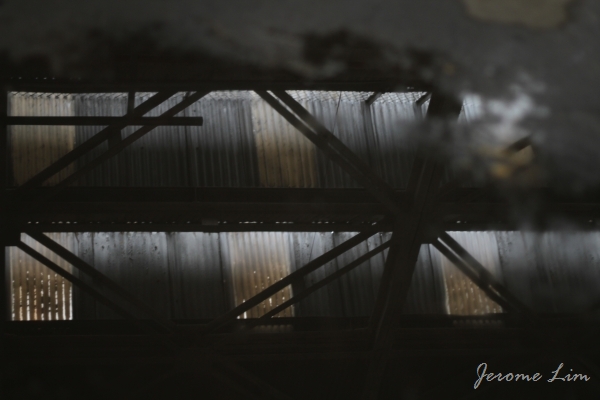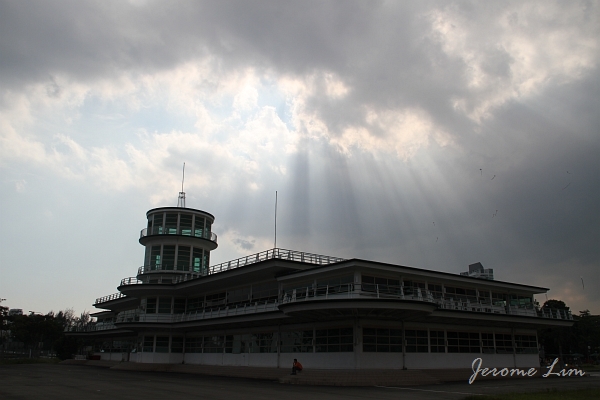[Do note that if you are planning a visit to the Biennale at Old Kallang Airport, the entrance is at Stadium Link, off Geylang Road, a short walk away from Kallang MRT Station. A link to a Google Map with the specific location of the entrance can be found at the end of this post].
Glancing at the headline of yesterday’s article on page 2 of the Life section of the Straits Times, which read “Biennale’s Kallang site not ideal. Visitors say that Old Kallang Airport, one of four venues for the art event, is difficult to get to and very stuffy”, and the lack of interest that is apparent at the venue so far with the exception of Saturday’s Open House Opening Party, one certainly can’t help but have a feeling that the choice of the site of the Singapore’s first civil airport, Old Kallang Airport, wasn’t a good one. I for one, did not mind the absence of a crowd, as that provided me with an opportunity to explore the marked historic site at leisure taking in as much as I could, grateful for the opportunity to explore buildings that I had previously only glanced at from behind a fence. In walking around, I couldn’t help but feel that it was a brilliant idea to do so, not just from the perspective of providing the public access to what had for long otherwise been a closed-off site, but also that the site was ideal for such an event, providing the spatial requirements required that does not exist in the confines of the museum buildings and sites in the city centre. Yes, maybe the site does seem a world away from the convenience of the city, but it isn’t really too far away and readily accessible via public transport, with the Kallang MRT station being a short enough walk away from the entrance to the site. Perhaps what is lacking isn’t the convenience that some have voiced their opinions about, but the information that the public needs to know.

The sign at the entrance of Old Kallang Airport.

The entrance of Old Kallang Airport.
I guess I am one for old places, especially the few that reamin that I can identify in some way from the childhood I had in a Singapore time has erased. The distinctive terminal building of the old airport with its control tower, which by the time I arrived in the world, was used by the People’s Association (PA) as its headquarters, had always been one that I had associated with Kallang and the Nicoll Highway, rising on the left of the east bound carriageway of Singapore’s first highway built after the airport had ceased operations. That would be the approach to the old Guillemard Circus and the wonderful neon signs that I somehow associate with the roundabout. There were many times that I had passed the building on foot as well, cutting on the side of it through from Kallang Road on the way to the National Stadium to catch a match or in the two months that I would have walked by on an almost daily basis on the way to Jalan Bennan Kapal. The tower adorned with the rings of the PA’s logo, had always caught my eye, rising somewhat defiantly and proudly to remind us of its past as Singapore’s first civil airport all those years back.

The distinctive terminal building which is a landmark in the area.

Another view of the terminal building.

The entrance gate to the terminal building.

Perhaps the inspiration for this set of photographs ... a work on display in the terminal building.
The reminders of its previous role had been everywhere, with names such as “Old Airport Road” and Dakota Crescent around. So even with me not having seen it used as an airport, I had been aware of it since I could remember … The airport had I was to discover, was built as an airfield on the site of land reclaimed from the swampy Kallang Basin in 1937 at the cost of S$9 million. It was opened very grandly by the then Govenor of Singapore, Sir Shenton Thomas, who flew in from Seletar for the occasion with some 70 aircraft there to mark the occasion. The location next to the Kallang Basin proved useful as it also allowed seaplanes to land. It was used by the Japanese who built a paved runway during the occupation, and refurbished by the British on their return. And although there were plans to expand and upgrade the airport the the end of the 1940s and early 1950s, it was thought that effort involved would prove too costly and Kallang was abandoned for a new inetrnational airport at Paya Lebar. Paya Lebar started operations in 1955 and that saw the last of Kallang as a civil airport, with the PA moving into the site in 1960. On the evidence of old photographs, the hangars were used by the Public Works Department (PWD) after the airport closed. The bulk of the location of the main runway was then transformed into Kallang Park one which the Oasis Restaurant, Wonderland Amusement Park and later the National Stadium, Indoor Stadium and Kallang Leisuredrome was built.

The main hangar next to the West Block.

The West Block and the main hangar off the window of the terminal building.

A smaller hangar, once used as a second hand car showroom.

An auxiliary building.

Another view of the smaller hangar.
It was certainly nice to walk around the old site and reflect on this, and hence the theme of this post … much of the old airport grounds that are left have been left in not so much its original state, but in a state that perhaps the PA had left them in – which I thought wonderfully complemented the exhibits. That also meant a lot of the wear and tear was evident from not just the use of the buildings by the PA, but the hangars by used car dealers at some point in time – I remember seeing them still at the end of the 1990s passing by after a concert at the Indoor Stadium. That provided me with an alternative view of the buildings – reflected off puddles of water and off windows and mirrors. I certainly did not get enough of it on the two occasions that I visited and I will certainly return for more.

A Toast Box cafe set up in one of the smaller hangars.

The side of a hangar.

The roof of the smaller hangar.

The main hangar.

Ventilation openings on the side of the main hangar.

The inside of the main hangar.

Roof of the main hangar.

Windows on the side of the main hangar.

Windows on the side of the main hangar.

Some of the auxiliary buildings on the premises - I understand that these were used by the Singapore Chinese Orchestra in the 1990s.

A newer auxiliary building ... perhaps added in the 1950s as an expanded air traffic control centre.

A peek under a marquee.

Another view of the terminal building and an auxiliary building.

A reflection of the East Block on a mirror mounted on an auxiliary building.

A last look ....
This slideshow requires JavaScript.
What’s to become of Old Kallang Airport? Thankfully, we should see that it is conserved for our future generations – it would be nice to see it turned into some kind of aviation museum though:
URA Letter to the Strait Times, 5 Mar 2010
URA has plans for old Kallang Airport site
I THANK Mr Edwin Pang for his Forum Online letter last Friday, 'Turn site into civil aviation heritage centre'.
The former Kallang Airport is located within Kallang Riverside, which is envisioned to be a new lifestyle hub at the fringe of the city area under the Urban Redevelopment Authority's (URA) 2008 Master Plan.
The former Kallang Airport passenger terminal building with its distinctive art deco structure, as well as the office buildings, former hangar, Old Airport Square and other historical structures, was designated a heritage area and conserved in 2008 to preserve memories while allowing for a new lease of life.
In future, they will be adapted to new uses as part of a future development centred on the conserved Old Airport Square, offering a wide range of lifestyle, entertainment and retail facilities.
In January, the Singapore Biennale committee announced that it was considering the former Kallang Airport as a venue for the festival next year. URA and the Singapore Land Authority are glad that the artistic community has found heritage buildings to be suitable venues for contemporary art events. Past editions of the Biennale were also held in heritage environments.
The synergy between heritage buildings and contemporary arts is useful in bringing the awareness of our conservation buildings to the wider public and helps to endear our heritage buildings to Singaporeans.
Hwang Yu-Ning (Ms)
Group Director (Physical Planning)
Urban Redevelopment Authority
Getting to Old Kallang Airport:
The entrance to Old Kallang Airport is located at Stadium Link, off Geylang Road and is a ten minute walk from Kallang MRT Station. Please click on this link for the specific location.








































































































































































































































































